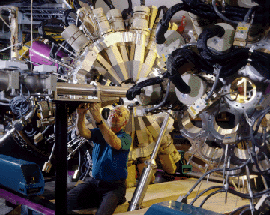Germanium semiconductor detectors fan out from the target chamber
of the Gammasphere, which will provide a 100-fold increase in sensitivity
over previously existing detector systems.
Though protons and neutrons were discovered (respectively) in 1909 and 1934,
exploring just how they combine and behave in forming an atomic nucleus remains
a daunting challenge. Nuclei are extremely minute -- the diameter of a nucleus is
about 1/100,000th the diameter of the whole atom, and they can be made to
rotate extremely rapidly, using particle accelerators such as LBL's 88-inch
cyclotron. Gammasphere detects gamma rays given off as one of these nuclei
spins down, allowing experimenters to learn about nuclear structure and
properties.
The Gammasphere consists of an array of germanium
semiconductor detectors that surrounds the spherical surface of small target
chamber. A beam from the 88-inch cyclotron is directed into this chamber onto
a metal foil target, creating collisions between nuclei. When two nuclei
collide off-center, they fuse to create a rapidly spinning, heavier nucleus.
The rate of spin is extraordinarily fast -- in its one-billionth of a second
lifetime, a superdeformed nucleus will spin about as many times as the earth
has spun since its creation some 4 billion years ago.
The laws of quantum mechanics dictate that the spinning nuclei cannot slow down smoothly,
but instead must shed energy by hopping down from one energy level to the next.
Nuclei having different numbers of protons and neutrons, or different
arrangements of these particles, emit their own characteristic spectrum or
"band" of gamma rays which Gammasphere detects with unprecedented sensitivity.
These unique signatures paint a picture of the properties of the nucleus,
including the size, shape, symmetry, and flow patterns. Such information could
help solve one of the reigning mysteries of nuclear science -- the phenomenon
called "band twinning" in which identical gamma spectra are obtained from
superdeformed nuclei containing different numbers of protons and neutrons.
Gammasphere is now being phased into full scale operation, and should have
all of its 110 detectors installed by the Fall of 1995. In its "early
implementation" phase it has operated with 30 to 55 detectors for almost 5000
hours at the 88-Inch Cyclotron, which has had less than 2% downtime and 7%
tuning time -- a remarkable performance.
-- Jeffery Kahn
 Nearly two hundred researchers from institutions all over
the world have come to LBL to work with a detector that opens a new window on
the unseen, enigmatic interactions that take place inside the atomic nucleus.
This new detector, the Gammasphere, will provide a 100-fold increase in
sensitivity over previously existing detector systems.
Nearly two hundred researchers from institutions all over
the world have come to LBL to work with a detector that opens a new window on
the unseen, enigmatic interactions that take place inside the atomic nucleus.
This new detector, the Gammasphere, will provide a 100-fold increase in
sensitivity over previously existing detector systems. 
 Return to Highlights Table of Contents
Return to Highlights Table of Contents